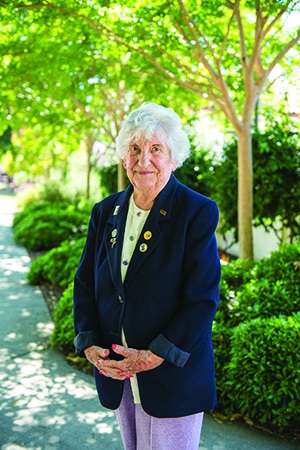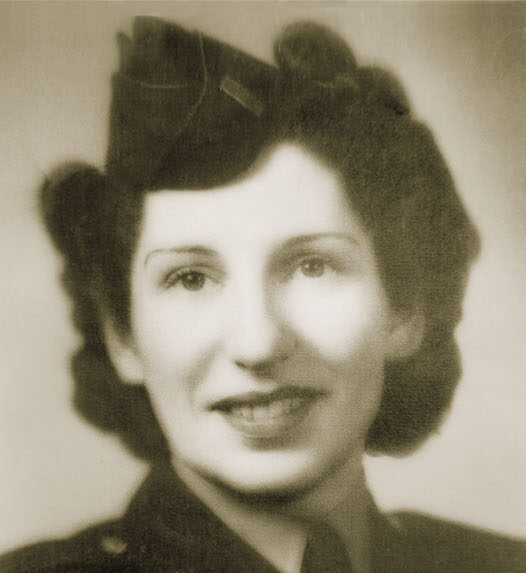
JANE BOOTE was born on Christmas Day 1919 in Erie, Pennsylvania, and trained in nursing at Allegheny General Hospital in Pittsburgh. She was waiting for her State Board of Nursing certification when the U.S. entered the war. Jane did too, serving as an army nurse and having a host of experiences she could never have imagined. After leaving the service in October 1945, she worked with the Veterans Administration until 1976. Now 99, she lives at the California Department of Veterans Affairs Home in Yountville.
How did your army career come about?
I hadn’t thought about joining, but after Pearl Harbor, everything became much more acute. The army recruiters came around, and as soon as we passed our state boards, about a third of our class signed up. If I had seen the navy nurses’ hats, I would have joined the navy [laughing]. I liked their hats much better than ours. But I got to travel much more than the navy nurses.
Where were you first assigned?
I was stationed at Camp Lee, Virginia, for several months before transferring to Walter Reed General Hospital, in Washington, DC. I was working in the officers’ ward when three of the Doolittle Raiders [who conducted the April 18, 1942, bombing raid on Tokyo] came back. I got to know Harold Watson, as well as Charles McClure, who had suffered two broken shoulders, and Ted Lawson, who later wrote the book Thirty Seconds Over Tokyo. Lawson was very badly injured and lost his leg. I was there when his wife Ellen first came to see him. He didn’t want her to come until he had gotten his prosthetic leg, but when she came in, he was so excited that he forgot that his new leg wasn’t attached. He jumped out of bed and fell flat on his face.
In 1944 they made a film from the book, in which Van Johnson portrayed Ted Lawson.
It was very accurate because Lawson himself was involved, but there was one thing wrong. As Lawson’s plane crash-landed, he went through the windshield and lost all his teeth. When Hollywood made the movie, the one thing they could not bring themselves to do was to show Van Johnson without teeth! They did, however, show him falling flat on his face when Ellen came into his hospital room.
Did you ever meet Jimmy Doolittle himself?
The first time I met General Doolittle was when he came into the ward one night wearing a buck private’s uniform with no insignia. I immediately challenged his authority to be there, but about this time an officer came up and greeted him, saying “Oh, General Doolittle.”
What did you do?
I thought I would die but, as with all great people, he was very gracious. He said, “Don’t worry about it little lady, you were just doing your job.” I got to know him very well. He came at all hours of the night to check on his “boys.” In around 1960, I started going to the Doolittle Raider reunions so I got to know a number of the others besides the ones I took care of. I went to their final reunion in Pensacola in 2013.
How long were you at Walter Reed?
I was so concerned that I was going to be stuck in that general hospital for the rest of the war, so when they asked for volunteers, I signed up for overseas. We went to Boston and shipped out for Iceland.
What was that like?
This was in December 1942, and we didn’t realize that the North Atlantic was one of the worst places in the world. It was so cold that everything froze up. There were 800 soldiers and nine of us replacement nurses aboard. We started out with a convoy, but lost track of it on the second night. Maybe it was a good thing that we were a small ship; the U-boats couldn’t see us. Everybody who came to Iceland claimed that either the ship before them or the ship after them was sunk. It took us three weeks to get to Iceland. I tell you, we all grew up on that trip.
How long were you there?
I rotated back in January 1944. They gave us a choice of going to England or back to the States. After a year, I was ready to go back. They gave me a choice of where I wanted to be stationed, so I said “any place west of the Mississippi, because I’ve never been there.” I had never traveled more than 100 miles from home when I went in the service. I was sent to Fitzsimons Army Hospital near Denver.
Did you go back overseas?
In fall of 1944. I thought for sure I was going to be sent to the South Pacific, so I was relieved when I learned that we were going to Europe. As bad as Europe was, it was not as bad as the South Pacific. I don’t take heat very well—or snakes. We disembarked at Cherbourg, France, and were assigned to an evacuation hospital south of the Bulge. We moved a lot, following the troops. But when General Patton got to going so fast, and casualties were coming back less and less, we stayed put for a while near Neufchâtel, in eastern France, south of Belgium.
Where did you experience the most intense fighting?
Probably in Luxembourg because that was the most active area at that time. Occasionally, bullets would hit our tents—but not often because the guys were pretty good at protecting us.
What types of injuries did you see?
There were a lot of wounds to the chest and abdomen, and to the arms and legs, but we didn’t see head wounds very often. We didn’t do a lot of amputations because there weren’t a lot of times, as in later wars, when people stepped on mines or improvised explosive devices; the armies were moving too fast to plant weapons like that. We had some bad injuries, but we lost relatively few; every frontline unit had medics to provide immediate care, so if the wounded made it to one of the field hospitals, their chances for survival were good. It always made us happy knowing that if they made it to us, they would likely survive.
Were there any lighter moments to break the routine of combat action?
I don’t remember a lot, but one time the troops liberated a French monastery that made this wonderful peach brandy [chuckles]. We were stationed not far away, and when the GIs took it over, they came back and brought us up to it. Oh my goodness, that brandy was good! It was so smooth you didn’t realize how much you were drinking. That was a memorable moment. It was a beautiful place.





